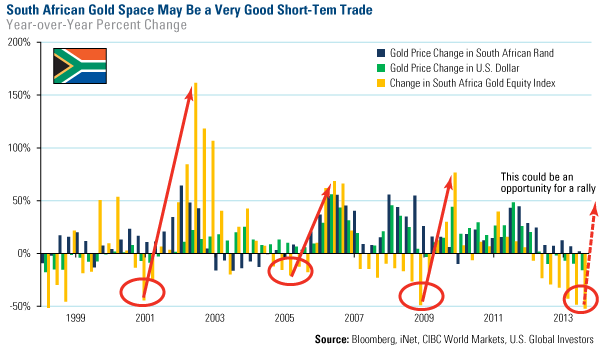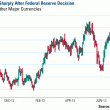Gold Market Radar (September 23, 2013)
For the week, spot gold closed essentially flat at $1,326.05, down $0.34 per ounce, or -0.04 percent. Gold stocks, as measured by the NYSE Arca Gold Miners Index, gained 0.10 percent. The U.S. Trade-Weighted Dollar Index lost 1.25 percent for the week.
Strengths
- The Federal Reserve unexpectedly refrained from reducing the $85 billion pace of monthly bond buying, saying it needs to see more signs of lasting improvement in the economy. In Wednesday’s press conference, chairman Ben Bernanke said “conditions in the job market today are still far from what all of us would like to see.” He orchestrated the most aggressive easing in the Fed’s 100-year history, pumping up the balance sheet from $869 billion in August 2007 and holding the main interest rate close to zero since December 2008. Bernanke added in his press conference that the first interest rate increase may not come until the jobless rate is “considerably below” 6.5 percent. Gold closed at $1,364.02 on Wednesday, gaining 4.07 percent or $53.38.
- Attendance at next week’s Denver Gold Forum will match or exceed last year’s record even though gold is down, said Tim Wood, executive director of the Denver Gold Group. Investors account for 73 percent of non-industry registration so far, up from 69 percent last year, while so-called sell-side delegates have declined to 22 percent, from 27 percent a year earlier. The event has received increasing interest from value investors who traditionally haven’t had exposure to gold equities. The Denver Gold Forum will be attended by 166 mining and exploration companies, representing about 88 percent of global gold production.
- SEMAFO outlined new gold reserves at its Mana mine in Burkina Faso that are set to raise mineable grades considerably. Haywood Securities analyst, Kerry Smith, noted the new reserves boost overall reserves to 2.4 million ounces of gold at Mana and the grade increases to 2.77 grams per ton from 2.31. SEMAFO gained 22.4 percent this week.
Weaknesses
- IAMGOLD and its joint venture partners, AngloGold Ashanti and the government of Mali, have decided to suspend mining activities at the Yatela Mine, effective September 30, 2013. AngloGold Ashanti is the operator of the gold mine, which has been in operation since 2001. The initial closure of the mine was planned for 2007. The decision to close the mine reflects a combination of factors, including miner safety in the pit, the drop in the spot price of gold, and the reduction of profit margin.
- Mining group Anglo American has pulled out of the Pebble copper project in Alaska, one of the largest undeveloped copper deposits in the world, but also an environmentally challenging operation that has been studied for almost three decades. Anglo has vowed to halve a $17 billion project pipeline and bring down the cost of keeping options like Pebble open.
- Gold demand in India is poised to decline during the main festival season as the weakest economic growth in a decade curbs spending and volatile prices spur investor selling. Sales of jewelry, coins and bars between August and November are expected to be lower than a year earlier because of the slowdown along with a bullion shortage caused by central bank curbs on imports.
- Papua New Guinea’s government has taken 100 percent ownership of the controversial Ok Tedi gold and copper mine following a lingering dispute with a development fund. Also, a 12-year old immunity deal with the mine’s former owner, BHP Billiton, for environmental damage in the country’s Western Province, was removed. Former Prime Minister Mekere Morauta has criticized the government’s actions, accusing it of theft and signaling a likely court challenge.
Opportunities
- Leon Esterhuizen of CIBC suggests that South Africa’s gold space may be a very good short-term trade. His chart below shows the year-on-year change in the gold price in both rand and U.S. dollar terms against the same year-on-year change in the South Africa Gold Equity Index. “The key to the usual sharp run that tends to follow the current situation (seen only three times in the past 15 years) seems to be a slight increase or turnaround in the year-on-year U.S. dollar gold price,” he explains. A sharp sell-off in South African gold equities on the back of current labor strikes should be seen as a proper opportunity to get invested in advance of the very sharp turn in profitability that the rather high rand gold price appears set to deliver in early 2014.
- The U.S. House of Representatives passed H.R. 761, the National Strategic and Critical Minerals Production Act, which streamlines mining permitting processes and allows the United States to more efficiently and responsibly develop mining resources. The Republican-led U.S. House of Representatives approved it, but the question remains as to whether the proposed act will again die in the U.S. Senate, which is controlled by Democrats.
- “Barrick Gold shares are no higher than they stood in 2003 when gold was around $400 an ounce,” Andrew Bary wrote in a Barron’s article that made the case for the world’s largest gold miner. The ill-advised Equinox purchase, a 75 percent dividend cut, and a lack of cash flow put the company in the penalty box. Barrick is expected to produce around 7.2 million ounces of gold this year, and is one of the more highly levered names in the space. However, this “probably means more upside if gold rebounds.” Barrick gained 5 percent this week.
Threats
- Looking forward, while tapering uncertainty may return for the October Fed meeting, Deutsche Bank economists believe the likelihood of an October taper is reduced. The first move is now forecasted to be in December. Deutsche’s commodity team expects “the bounce in gold likely to be short-lived as long term interest rates, the equity risk premium, and the U.S. dollar will eventually conspire against a sustained rally in gold.”
- At the beginning of this week, Goldman Sachs’ senior commodity analyst Jeff Currie warned that gold could fall to $1,000 an ounce or lower. Goldman’s “sell gold short” call in April this year was immediately followed by a huge decline in the price of gold. The market will undoubtedly take notice of this latest report.
- David Franklin, market strategist at Sprott Asset Management, asks “given the manipulation we know has occurred in the oil and LIBOR markets, could gold and silver be any different?” The London Bullion Market Association website states that the gold price is “fixed” by telephone twice each London business day at 10:30 a.m. and 3:30 p.m. Last week, a new study emerged that suggests that the pricing mechanism may not be so transparent and that some market participants could be profiting from information leaked during the fixing process. Andrew Caminschi and Richard Heaney published their analysis of the fixing process in “The Journal of Futures Markets.” They found statistically significant return advantages for informed traders in the four minutes following the start of the fixing. While the study does not analyze or comment on the process by which the gold price is determined, it does provide evidence that information during the process is being leaked somehow to the advantage of some market participants.















